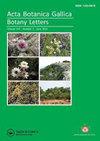A touch of orchids from Samos (Greece)
引用次数: 0
Abstract
The International Conference about Temperate Orchids Research and Conservation (TORC’15) was held on the island of Samos, Greece, from 14 to 18 April 2015. It was organized by the Sails-For-Science Foundation (a non-profit organization based in Germany, promoting a sustainable balance between nature and society for small island communities worldwide) under a sponsorship by the Société Botanique de France and several other societies. In this issue, we publish three papers spanning from this international meeting. The plant family Orchidaceae emerged on our planet 112 million years ago branching out to over 25,000 species with compatible populations of dazzling diversity comprising almost 8% of all vascular plants, unlike any other plant family (Pridgeon et al. 2001–2014). Their resilience to extremes reaches from tropical abundance to remote places in high latitudes and from sea level to high altitudes into the upper limit of continuous vegetation, with colonization of outstanding niches such as epiphytic habitats or heterotrophic nutrition in forests (Givnish et al. 2015). Moreover, they display tight interactions, sometimes mutualistic, sometimes parasitic, with their associated pollinators and mycorrhizal fungi (Selosse 2014). Why did this angiosperm family become so dominant during the race for the tree of life? What innovative mechanisms, behaviours and physiological processes have made its conquest so successful? Although a number of intriguing phenomena of the orchid life cycle, relating to mycorrhiza, pollination, epiphytism, crassulacean acid metabolism (CAM), among others, has been unveiled, vast gaps in understanding of this success story of ecology and evolution remain. (A) On the molecular level, what are the physiological modes of action of the orchid plant itself and its choices for a thriving environment in respect to the geochemical, microbiota, embryophyta, insect and herbivore cross-signalling? (B) On the ecological level, what networks of co-evolutionary processes and which implications from abiotic change alter the homeostasis of orchid populations? Land abandonment for economic reasons and global climate change are the assumed main factors for the change or even the irretrievable decline of orchid biodiversity (e.g. Robbirt et al. 2014). The greatest challenge facing anybody interested in these charismatic plants is the vanishing of valuable orchid species in human-sculpted landscapes (Swarts, and Dixon 2009). Europe has now less than 1% land remaining in intact wilderness vegetation (Gillespie 2013). In Australia alone, 25% of the global orchid biodiversity has disappeared. Valuable secondary metabolites of orchids providing original potentials as therapeutics may be lost forever. (C) Therefore, the application of orchid research for their conservation needs to become mainstream. Only concerted interdisciplinary research and the involvement of the general public, starting with the orchid enthusiasts, all united by the passion for this family of flowers, may deepen our understanding. The aim of this conference was to provide a stimulating forum to this diverse group of people and to address the above-mentioned cornerstones (A), (B) and (C). Botanists, biologists, conservationists, chemists, ecologists, pharmacists, geneticists, orchidologists and others from more than 30 countries and five continents gathered on Samos contributing cutting edge science in seven sessions: (i) updates on the Greek and world orchid flora, (ii) systematics and population genetics, (iii) mycorrhizal studies, (iv) pollination, floral deception and reproductive success, (v) ethnobotany and propagation, (vi) population dynamics and determinants, and (vii) conservation. The island of Samos is embedded in an archipelago in close proximity to Minor Asia. These biogeographic conditions of the island sustain a high number of orchid taxa, especially in the genus Ophrys (see list below). The conference included extensive field trips to the charismatic flora during the blooming season on the island. Successful conferences are judged by their outcomes. The stimulating and convivial surroundings strengthened existing collaborations, and started a number of new research and conservation initiatives around the globe. To name a few examples, the establishment of an urgently needed European orchid conservation centre is being pursued, building on the experiences and in coordination with other continental conservation centres such as the North American Orchid Conservation Center. The closely interrelated orchid populations of the Aegean and Minor Asia are subject to immense habitat destruction, particularly through the unsustainable production of the traditional salep. In consequence of this conference, several research and conservation organizations from Greece, Germany and Turkey formed a consortium and formulated an international orchid conservation programme with the一抹来自希腊萨摩斯岛的兰花
2015年4月14日至18日,温带兰花研究与保护国际会议(TORC’15)在希腊萨摩斯岛举行。它是由Sails-For-Science基金会(一个总部设在德国的非营利组织,促进全世界小岛屿社区在自然与社会之间的可持续平衡)在法国植物学会和其他几个学会的赞助下组织的。在本期中,我们发表了三篇关于这次国际会议的论文。兰科植物家族在1.12亿年前出现在我们的星球上,分支出超过25,000种,具有令人眼花缭乱的多样性,几乎占所有维管植物的8%,不像任何其他植物家族(Pridgeon et al. 2001-2014)。从丰富的热带到高纬度的偏远地区,从海平面到高海拔,再到连续植被的上限,它们对极端环境的适应能力达到了极限,并在森林中定植了出色的生态位,如附生栖息地或异养营养(Givnish et al. 2015)。此外,它们与相关的传粉媒介和菌根真菌表现出紧密的相互作用,有时是互惠的,有时是寄生的(Selosse 2014)。为什么这个被子植物家族在生命之树的竞争中占据如此大的优势?是什么创新机制、行为和生理过程使它的征服如此成功?尽管兰花生命周期中许多有趣的现象,包括菌根、授粉、附生、天冬酸代谢(CAM)等,已经被揭示出来,但对这一生态学和进化的成功故事的理解仍然存在巨大差距。(A)在分子水平上,在地球化学、微生物群、胚胎群、昆虫和草食动物的交叉信号方面,兰花植物本身的生理作用模式和对繁荣环境的选择是什么?(B)在生态水平上,哪些共同进化过程的网络和非生物变化的哪些影响改变了兰花种群的动态平衡?经济原因导致的土地荒废和全球气候变化被认为是导致兰花生物多样性变化甚至不可挽回的下降的主要因素(例如robert et al. 2014)。对这些有魅力的植物感兴趣的人面临的最大挑战是,在人类雕刻的景观中,珍贵的兰花物种正在消失(Swarts, and Dixon, 2009)。欧洲现在只有不到1%的土地保留完整的荒野植被(Gillespie 2013)。仅在澳大利亚,全球25%的兰花生物多样性已经消失。兰花中具有原始治疗潜力的次生代谢产物可能永远丢失。(C)因此,兰花保护研究应用需要成为主流。只有跨学科的协同研究和公众的参与,从兰花爱好者开始,所有人都对这一花卉家族充满热情,才能加深我们的理解。这次会议的目的是为这一多样化的人群提供一个令人兴奋的论坛,并解决上述基石(a), (B)和(C)。来自五大洲30多个国家的植物学家,生物学家,保护主义者,化学家,生态学家,药剂师,遗传学家,兰花学家和其他人聚集在萨莫斯岛,在七个会议上贡献了最前沿的科学:(i)希腊和世界兰花区系的更新,(ii)系统学和群体遗传学,(iii)菌根研究,(iv)授粉,花的欺骗和繁殖成功,(v)民族植物学和繁殖,(vi)种群动态和决定因素,以及(vii)保护。萨摩斯岛位于小亚细亚附近的一个群岛中。岛上的这些生物地理条件维持了大量的兰花分类群,特别是在Ophrys属(见下面的列表)。会议包括在岛上开花季节对迷人的植物群进行广泛的实地考察。会议的成功与否取决于会议的结果。刺激和欢乐的环境加强了现有的合作,并在全球范围内启动了许多新的研究和保护计划。举几个例子,目前正在建立一个迫切需要的欧洲兰花保护中心,以经验为基础,并与北美兰花保护中心等其他大陆保护中心协调。爱琴海和小亚细亚地区密切相关的兰花种群正遭受巨大的栖息地破坏,特别是由于传统salep的不可持续生产。这次会议的结果是,来自希腊、德国和土耳其的几个研究和保护组织组成了一个联盟,并与国际兰花保护协会制定了一个国际兰花保护计划
本文章由计算机程序翻译,如有差异,请以英文原文为准。
求助全文
约1分钟内获得全文
求助全文

 求助内容:
求助内容: 应助结果提醒方式:
应助结果提醒方式:


